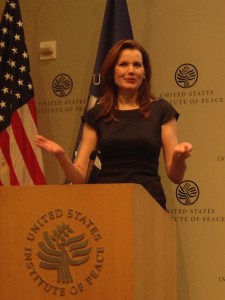Second Global Symposium on Gender in Media
Posted on September 24, 2014 at 10:49 am

Yesterday, I was honored to attend the Second Global Symposium on Gender in Media, held a the United States Institute of Peace in Washington, D.C. The keynote was delivered by Oscar-winning actress Geena Davis, founder of the Geena Davis Institute on Gender in Media. The highlight of the event was the presentation of new research by Dr. Stacy Smith, Ph.D. and her team at the USC Annenberg School for Communication & Journalism, looking at gender bias in films produced by the 11 countries with the most established film industries. Films jointly produced by the US/UK and those from India had the poorest results in portraying women, whether the issue was number of speaking parts/named characters or number of women in professional roles. Perhaps the most surprising result was that even in crowd scenes, women made up only about 17 percent of the roles. Movies portray a world in which women are outnumbered by men five to one. The study also found that women filmmakers — directors, producers, and writers — usually put more women on screen, except that as the budget increases, the number of female characters goes down. “We are responsible for exporting negative images of women around the world,” Davis said. Female characters are too often one-dimensional, skimpily clothed, sexualized, and portrayed as victims of violence. “The more TV a girl watches, the fewer options she thinks she has. The more TV a boy watches, the more sexist his views become.” Her approach is “collegial, private” meetings with filmmakers, who all insist that “it’s been fixed,” but are responsive to the data she presents. “Gender inequality is rampant,” concluded Dr. Smith. “Cinema turns a leering lens on females.” One element of her study revealed only three female characters in positions of political power. Two were portrayals of real-life leaders Margaret Thatcher and Angela Merkel. The third was an animated elephant. On screen, females hold only 22.5% of the jobs, as opposed to 40% in real life. Davis called on filmmakers to go through scripts and assign female names to half of the characters and make sure crowd scenes had gender parity. “I’m not asking them to add a message, just to recognize the message already created. Let’s not embed harmful and disempowering messages in media aimed at kids.”
